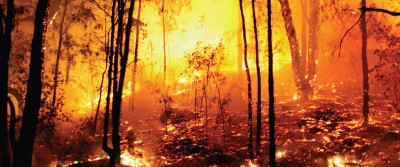Carbon Emissions Threaten Arctic

By Kevin Ritchart
While it’s easy to see the immediate impact of wildfires on people and places, the long-term impact on the environment may not always be clear.
Within the next 100 years, the soot that’s produced from the burning of fossil fuels and plants during wildfires — also known as black carbon — will not only continue to cause respiratory diseases and greenhouse warming, it will also accelerate the melting of Arctic ice.
Scientists estimate that rising temperatures and changing weather patterns will alter the location and the intensity of where wildfires are likely to burn, based on recent simulations. By the year 2090, wildfire seasons in several regions could last anywhere from one to three months longer than they do now. In regions that border the Arctic, soot emissions from wildfires could double, which would counteract the predicted soot-emission reductions from human activities during that time frame.
Predicting future emissions levels can be problematic because of variations in both weather and vegetation. Scientists put together three simulations in an attempt to predict soot-emission levels in the Arctic. The first simulation dealt with changes in vegetation. The second was a wildfire predictor. The results of the first two simulations were plugged into a climate simulator that produced the long-term findings for the Arctic region.
Reversing the Trend
If we don’t take steps to cut carbon emissions, overall soot emissions from wildfires will likely remain at approximately the same level, but the location will change. As wildfire season gets longer toward the end of the century, it’s estimated that wildfire soot emissions will increase by as much as 49 percent. In the tropics, emissions will decrease by 37 percent thanks to a number of factors, including changing land usage, fewer human-caused emissions and urbanization.
If wildfires shift northward, the Arctic will face further peril from falling soot that is expected to darken the ice and snow and accelerate the melting process. New simulations indicate that 53 percent more soot will settle in the Arctic by the end of the century, even if humans are somehow able to cut their own emissions in half.
While the simulations and the resulting statistics carry with them a potentially devastating environmental impact, scientists warn that they are just speculation at this point. There are too many factors at play to be able to accurately predict exactly what the melt rate of the Arctic will be 100 years from now.
CLASSROOM DISCUSSION
What can we do to reduce our personal carbon emissions?
What are some ways to prevent wildfires from occurring?
VOCABULARY
- Urbanization
- Carbon Emissions
